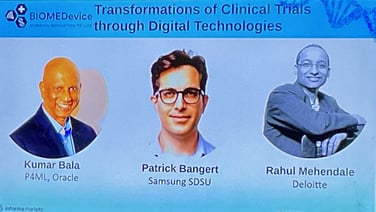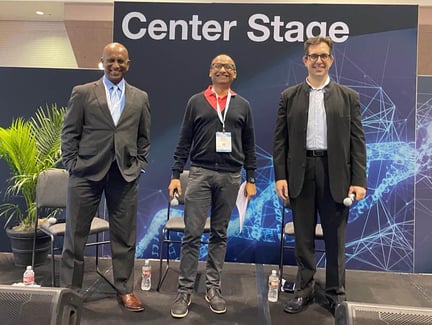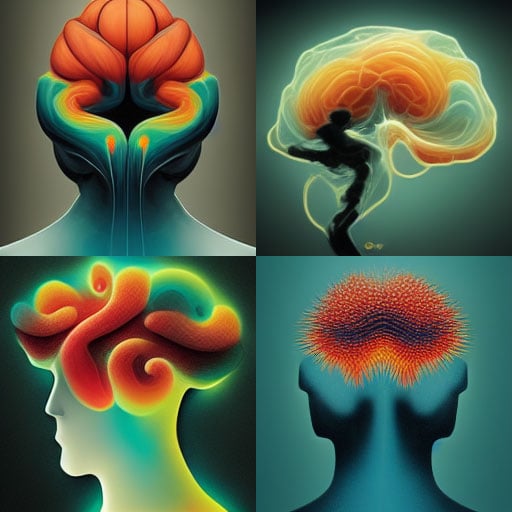Dr. Robert should grow UP!
UP disrupted Robert’s perfectly cosy post-pandemic existence by asking him to go to Silicon Valley on a mission to grow UP. That meant meeting existing members and recruiting new ones; finding a great location for a new UP Creative Hub in Silicon Valley, and connecting with a few of our big existing clients.
How could he say no?
Driving down Highway 101 to Santa Clara reinforces what a good decision I made choosing to live in San Francisco. My neighbourhood of Hayes Valley has every cuisine under the sun, some of them with a MICHELIN Gourmand Bib award. Where else in the world can I get authentic Xiao Long Bao, the delicious Shanghai soup-filled dumplings, next door to a perfect wood-fired oven baked Pizza Napoletana, or the best Laos-Filipino egg-roll stuffed chicken wings down the road on Valencia? And I can do it directly after listening to Patti Smith read her poetry and sing her songs. SF rocks.
Clinical trials and tribulations
The Santa Clara Convention Center hosted BIOMEDevice, a conference and trade show for developers of medical devices. What piqued my attention most was a panel discussion on how Digitalisation, Artificial Intelligence and Machine Learning (AI/ML) might transform clinical trials. To me, AI/ML are essentially black boxes, with a lot of data (some of questionable quality) going in, and lots of results (of equally questionable quality) coming out, upon which medical devices and drugs might be approved and patients might be diagnosed. But how did the AI arrive at its conclusions? If what is going on inside the AI black box remains a mystery, I’m pretty sure that means we could lose control of quality, and our greatest fear; that AI is making decisions that are not to our benefit.
On the panel were some surprising names: representatives of Ex-Oracle, Insilico Medicine, P4ML, IndyGeneUS AI, Deloitte and Samsung SDSA. It sent a clear message that clinical data and their management is of great interest beyond the usual suspects of Amazon, Google, Apple and Meta – who I am sure have their own cunning plans.

Kumar Bala (ex-Oracle, Insilico Medicine, P4ML, IndyGeneUS AI) opened the panel to discuss the most recent trends, how these might impact clinical trials, and the low-hanging fruit that may propel forward the digital transformation of clinical trials.
Just wear it
Top of the list, said Rahul Mehendale of Deloitte is the rapid adoption of wearables: Apple Watches, FuelBands, Fitbits and other consumer devices have exploded in function, affordability, and the number of wearers in the last 5 years. This has led to a concomitant explosion of data on the ‘quantified self’, and not least the advent of the empowered consumer. We walk into a doctor’s office and, much to the chagrin of the GP, we proudly announce our self-diagnosis. (I must admit I have sinned: my VO2Max, according to my Apple Watch, has been consistently low since I got COVID. My doctor has humoured me, but has done absolutely nothing about it.)
Rahul also pointed out that our relation to healthcare services have radically changed since the pandemic: we expect physicians to be on-call 24/7, via an app. And the opportunities presented by profitable medical and consumer devices have diversified from the revolutionary but low-volume $10,000 prosthetic hips to high-volume $10 socks that extract data from our feet while we exercise.
What could all this possibly mean? Well, according to Patrick Bangert of Samsung SDSA, with all this information we could in principle move from today’s ‘sick-care’ closer to wellcare, where we get an early warning of a potential illness, be it exposure to a respiratory virus or the measurement of atrial fibrillation, or A-fib (the latter invented by Samsung, licensed to Apple), that can be treated preemptively before disease is a foregone conclusion. (Hey doc, what are you going to do about my VO2Max?). “In return,” adds Patrick, “the overall spend on everything in x-care would shrink, of course. Every dollar spent on wellcare has the potential of saving several dollars of sick-care”. Rahul proposes that by 2040, 60% of our healthcare spend should be on wellcare, compared to less than 20% today. In February 2021, Deloitte presented an actuarial study that, in one future scenario, a potential US$3.5 trillion ‘well-being dividend’ is waiting to be collected by 2040 if we succeed in transitioning from sick-care to wellcare.

Let’s get personal on physical data
Another major improvement would be the move from a ‘one-size-fits-all’ approach in healthcare, to precision medicine based on your conditions, your genetic disposition and your prevailing vitals, taking into account every relevant biomarker in your body. One major consequence of this thought: are we really going to permit the healthcare (and insurance) systems open access to our health data? If Facebook already considers you to be the product, how would the healthcare industry see us? As bags of warm, juicy data, waiting to be exploited? More of that below, when I discuss the consent process.
And now to the $64,000 question: how will these trends affect clinical trials? Clinical trials are one of the most expensive, time-consuming and risky phases of drug development, killing many potential drugs, therapies and medical devices from ever reaching the market. Sometimes their failure is warranted, but sometimes it is because of unsubstantiated drug efficacy caused, for example, by suboptimal patient sample populations, low resolution of data, and a host of other barriers that could potentially be addressed.
The benefits could be many. Patient enrollment could be much improved through the use of social media, capturing a more diverse population and counteracting the overrepresentation of, say, caucasians in the sample population, when the drug might work significantly better on people with a non-caucasian profile (this is just one example among many biases). Through remote monitoring of patients with wearables, data sampling could be continuous and consistent. Electronic diaries could request the patient's self-evaluated condition at regular intervals via her smartphone. There would be less need to visit a trial centre, and the trial could provide data to measure its progress in real time. The trial could even respond in real time by recruiting a modified patient profile in response to unexpected incoming results. All these factors could increase trial quality, save money and reduce risk. They hit all the hot buttons in the pharma and medical device industry, so it is in their interest to implement some of these strategies.
Medical devices and desires
What are the low-hanging fruit that could bring us closer to clinical trial utopia? “One clear approach is the strategy taken by Insilico Medicine which focuses on using AI for drug discovery, identifying molecules, and running clinical trials”, said Kumar. What this could mean for clinical trials is more power to predict the success rate of a trial, identifying the weak points in trial design, and adopting established best practices in the industry.
Other opportunities include the interoperability of information, so they are all working together regardless if the source is Google, Apple, Microsoft or 23andMe; the use of blockchain to deliver validated data to clinical trial sites; the use of AI/ML to speed up data processing and cleaning; the treating of data so that they meet the various interests of doctors, patients and advocacy groups; and not least: for some organisation (like a regulatory body, a not-for-profit organisation or a for-profit company) to take the responsibility to build a platform to gather and coordinate the medical data, ensure their security and provide access to them. The panel speakers made the important point that we must change our own mindset to think of the demonstration of value of such a resource, rather than considering only the benefit of time to market. Can we ask some responsible multi-billionaires to step forward, please? We have a job for you.
The three main reasons for this need are quality, Quality and QUALITY. No one will fully trust the results unless information is gathered and secured with integrity, sanitised from spurious results, and well annotated. It reminds me of previous human data initiatives like the Human Genome Project and the Human Protein Atlas - resources of vast undertaking, and equally essential to progress to the resource we are discussing here - the ‘Human Biodata Repository’, if I may be so bold as to give it a name.
Adding to the challenge is the prevailing regulatory ambiguity for approving the results of virtual clinical trials on virtual patients for medical devices and drugs. The FDA and the EMA would probably be more than interested – fascinated, even – in auditing a clinical trial based on such an audacious experiment, but there will be absolutely no guarantee that they would approve it. These bodies are uncertain what the regulatory environment should look like, according to Patrick Bangert.
Today, it takes 2 to 4 years to complete a clinical trial of a medical device, and 7 to 10 years for a drug, so there’s a lot of room to save time and money. Surely that must be a major incentive to address these huge challenges. Personally, I think it could hinge on making a trial design with these new digital tools that lowers the cost of the trial significantly with controllable risk, succeeding in getting the trial approved by the regulatory bodies, and then letting the world know about it. That would be extremely newsworthy.
The future of clinical trials is already here
Notice, so far, that this article has mainly discussed the impact of data, rather than the transformation of data to useful information, which is actually the most thought-provoking part. The panel members made some interesting statements about the future:
- Clinical trials will use AI and ML to analyse data and create information.
- Clinical trials will use new data sources and registries.
- Simulations will be more acceptable, e.g. model systems like organs-on-a-chip, 3D spheroids and tumoroids.
- Connected devices will play an increasingly important role in clinical trials.
And why do they know this? Because we have already started on the path of integration of AI/ML, remote data sources, models and devices. One example of this is the use of the aforementioned A-fib sensing to drive earlier interventions to preempt heart failure, dementia and stroke. And this is already available in some of today’s wearable devices.
Another example is the care of people with epilepsy. 65 million people suffer from the condition, and monitoring them in hospital is expensive and complex. Remote Patient Monitoring (RPM), parallel computing and machine learning are changing the landscape and the cost of care. Both Oracle and Xpert AI are active in this field.
Do we permit everything between consenting adults?
One final thought on the barrier to adoption; the consent process. We have all seen (and probably didn’t read) the wordy terms and conditions that we must consent to before being allowed to use an app or operating system. After all, if there were something sinister in there, wouldn’t someone flag it? Would you be so cavalier about it if this was about your health data? And the likelihood that you will consent to being a virtual patient in a virtual clinical trial is even more unlikely when there isn’t a friendly doctor or nurse who can reassure you that it’s perfectly safe to sign on the virtual dotted line.
The answer offered by Patrick was that we must lower the comprehension barrier by writing the terms and conditions in natural human language, and presenting them, for example, as a video with a person talking to you. Following that, if you have concerns, you can take part in an online Q&A session with a real human being.
The question remains if every adult individual should have the agency to make their health data freely available without education of the consequences.
What’s in the box?

In 1995, Brad didn’t like what was in the box. Today it might be different.
So what is going on inside the fevered superbrain of today’s AI? As Rahul said, “There’s not much intelligence in today’s AI, and not much learning in today’s ML. Basically, there’s a lot of statistical analysis of the data going on to recognise patterns and apply them to the inputs.”
However consoling that may sound, somehow I felt that it was only part of the answer. There are pretty wondrous things going on with AI right here, right now. Consider one of the most visible and visual examples of AI: the awe-inspiring leaps and bounds of AI imagery engines such as Midjourney and DALL•E. There is so much tagged image data out there on the internet, that these platforms can take plain language as input and create unique images that already impress us. Isn’t this type of AI representative of what we can achieve in healthcare?
The difference between perception and fact
“These novel AI visual tools and AI natural language tools like ChatGPT are different to healthcare AI in one very important way”, says Patrick. “When generating images or other data, accuracy is essentially meaningless, as it is simply interpreted as ‘beautiful’ in the eye (and the mind) of the beholder. ChatGPT is very entertaining but it is still useless for a factual exchange of valuable, insightful information. We cannot quantitatively measure which AI model is better for the given task at hand. In healthcare AI, accuracy is paramount and we must measure it as if our lives depend on it – which, in fact, they do”.

Poodle in a spacesuit on Jupiter - courtesy of Midjourney.

The human brain’s neocortex, thinking through movement - courtesy of Midjourney.
Patrick’s point is vital. Neither you, dear reader, nor I have ever seen a poodle in a spacesuit on Jupiter, nor how the human brain’s neocortex is best represented if thinking is related to movement, but these interpretations are found to be beautiful to our own perception. These images are not facts or insights. There is another intermediary function at work here: the subjective interpretation of the AI-generated image by the human mind.
Interpretation of clinical data by AI/ML cannot and should not achieve ‘beautiful’ results to our mind in the same way. It must achieve, at least and at most, strong, accurate and meaningful correlations in the data upon which humans can formulate further hypotheses that are worth testing.
But what do I know? Clearly, not everything. The application of AI/ML in clinical trials is ripe for basic research and investigation. Therefore I offer anybody with a serious AI/ML project the following:

Yes, I am a trained PhD and I offer you my free labour so that I can learn exactly what’s inside the black box of healthcare AI/ML – as well as my connection to one of the most powerful knowledge communities in the scientific and creative spheres: UP THERE, EVERYWHERE. Why do I want to do this? Because I think it is important that the benefits of AI/ML are communicated clearly, accurately and crisply.
Get in touch with me and let’s talk. First come, first served.